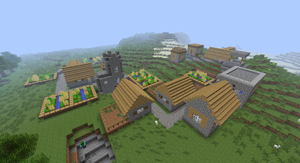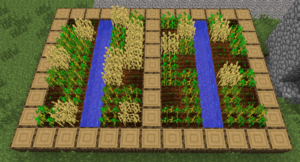Village
Villages are groups of buildings formerly inhabited by villagers that spawn naturally in plains or desert biomes. Village buildings in plains are made out of oak wood and cobblestone, while buildings in deserts are made out of sandstone. They are one of the most important structures to encounter, being the only sources of wheat, carrots, potatoes, and villagers; library buildings are also one of the few sources of bookshelves. Due to mysterious events possibly related to Steve's arrival in the world, when you encounter a village the villagers will all have been turned into zombie villagers. Finding and curing them using soul urns so you can trade with them is a vital part of progression.
Villages within 2250 blocks of spawn are abandoned, meaning they have no crops or villagers. Villages between 2250 and 3000 blocks away are partially abandoned, having wheat but no potatoes or carrots and also only lower-tier (peasant, butcher, and blacksmith) villagers.
Contents
Structure
Villages contain a variety of structures. In plains villages, these are made primarily of oak wood (both logs and planks) and cobblestone, while in desert villages they are made of sandstone. Regardless of material, the form of the buildings and other structures will be similar.
Villager homes
Different building types correspond to villager professions, so by recognizing the building types you can tell which villagers you'll get without having to cure them first. Each building will spawn with exactly one villager of the corresponding type, and possibly also a peasant. Peasant houses come in a couple different varieties and can spawn 0-2 peasants. These buildings have glass pane windows and wooden doors. The villagers will spawn as zombies trapped inside the buildings, but they will quickly break the doors and escape. This means you'll usually encounter the doors lying on the ground next to the entrances.
| Villager Type | Image | Description |
|---|---|---|
| Butcher | 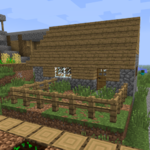
|
The salient features of butcher's shops are their double stone slab counter and fenced off backyard, which is behind the building and is accessed through a door. Butcher's shops have small seating areas made of two wooden stairs and a table between them. Presumably the yard was for the butcher to raise animals and the counter was for cutting up meat. |
| Blacksmith | 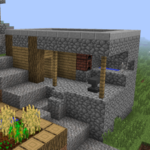
|
A smithy is a fairly complex building, with stone/sandstone slabs lining the roof. On the front of the building is a small porch with an awning supported by fences. On the porch is a small pool of water, surrounded on one side by iron bars. Nearby there are two brick ovens and an anvil. An opening leads to a small back room with a chest containing some loot. |
| Librarian | 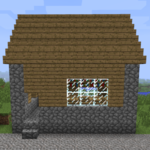
|
Libraries are longer and narrower than other buildings. They are easy to recognize by their row of bookshelves inside (there are always exactly 7). Beneath they have a row of wooden or sandstone stairs in front of two tables, and they also have larger windows than any other kind of buildings. |
| Priest | 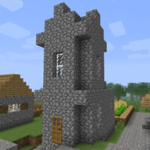
|
Churches are tall buildings, with stairs used to shape an interior "altar". Plains churches will be entirely cobblestone, while desert ones are sandstone. They have a small 3 floor tower equipped with ladders and glass panes, with a balcony on the top. |
| Peasant | 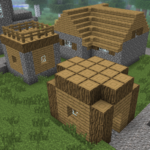
|
Peasant houses come in three different types:
|
Farms
Farms can come in small and large varieties. All consist of farmland plots separated by rows of water, surrounded by wood logs or sandstone. The small farms contain two 7x2 plots of crops, separated by a row of water. Larger farms are essentially two small farms combined side-by-side, with a walkway down the middle in lieu of a third water row. One of the two rows of crops will always contain wheat and the other can contain wheat, carrots, or potatoes. This means that every village will have wheat; some will have only wheat, while others will have wheat and carrots or wheat and potatoes; but there will never be both carrots and potatoes. All farms in a single village have the same selection of crops in them. It is rare but possible for a village to spawn with no farms at all.
Other components
Well: Wells are 2x2 pools filled with water, surrounded by cobblestone/sandstone walls, and have small roofs of cobblestone supported by fences. The wells are normally 10 blocks deep. There is always one well in each village. Wells usually spawn near the center of the village with roads leading out from all sides.
Road: Roads join all structures in the village. They are made of gravel in Plains villages, or sandstone in Desert villages.
Lamp post: Lamp posts can be found throughout villages. They are made of two stacked fences topped with a block, to which some burned out crude torches are affixed.
Partially abandoned villages
Partially abandoned villages occur between 2250 and 3000 blocks away from spawn. They are easy to recognize by their half-filled farms. They have the following differences:
- Buildings spawn with no doors and no glass panes in the windows.
- No priests or librarians spawn, even if the village has a church or library.
- Blacksmith buildings do not have ovens, chests, or anvils.
- Farms have only wheat and some of the farmland blocks are replaced by loose dirt.
Abandoned villages
Abandoned villages occur within 2250 blocks of spawn. They are just like partially abandoned villages except farms have no water and no crops at all, and there are usually no zombie villagers. Occasionally there will be a single peasant.
Rewards
- Villagers: The most critical feature. By curing the zombie villagers, you can trade with them to obtain many trading-exclusive items necessary to progress through the tech tree.
- Crops: A close second in importance. Village farms are the only sources of wheat, potatoes, and carrots. Wheat is found in every village while potatoes and carrots are rarer.
- Bookshelves: Villages can have 0-2 libraries, each of which has 7 bookshelves. Collecting them is necessary to improve your enchanting power.
- Blacksmith chests: The chest inside a smithy can contain iron tools and armor and is also one of the few sources of apples. Not all villages will have a smithy, however.
- Mystery meat: If you already have enough villagers, you can instead slay the zombie villagers to obtain raw mystery meat which is needed to breed wolves.
- Ladders: Found in a church. Unremarkable in the late game, but if you happen upon a village with a church early on (even an abandoned one) they are a nice perk. They otherwise require a crafting table and a surplus of string or hemp fiber to create.
Keep in mind
- Villages are optional as part of the setting for generated structures.
- Farms in the villages avoid overhanging by filling in the area below them with dirt. When the farm overhangs a ravine, this can cause a very tall rectangular dirt structure that at first glance almost looks like a chunk error.
- The well acts as the "center" of the village in reference to Minecraft's code. This explains why there is always exactly one well in each village.
- Sometimes buildings can generate so that their entrances are buried. You have to uncover the entrance, or dig in through the walls.
- Zombie villagers are very fast, can break down doors and survive in the sun, and like to chase animals. If your village has a certain building type but you don't find the villager that goes with it, it probably ran off somewhere. Zombie villages don't despawn so unless it fell into lava or got kicked by too many cows and died you can find it by searching the environment around the village.
- Zombie villagers will attack cured villagers, so make sure to isolate your villagers before starting to cure them!
- Breaking a plant before it's ready will give you nothing, so make sure the crops are fully grown before trying to harvest them.
